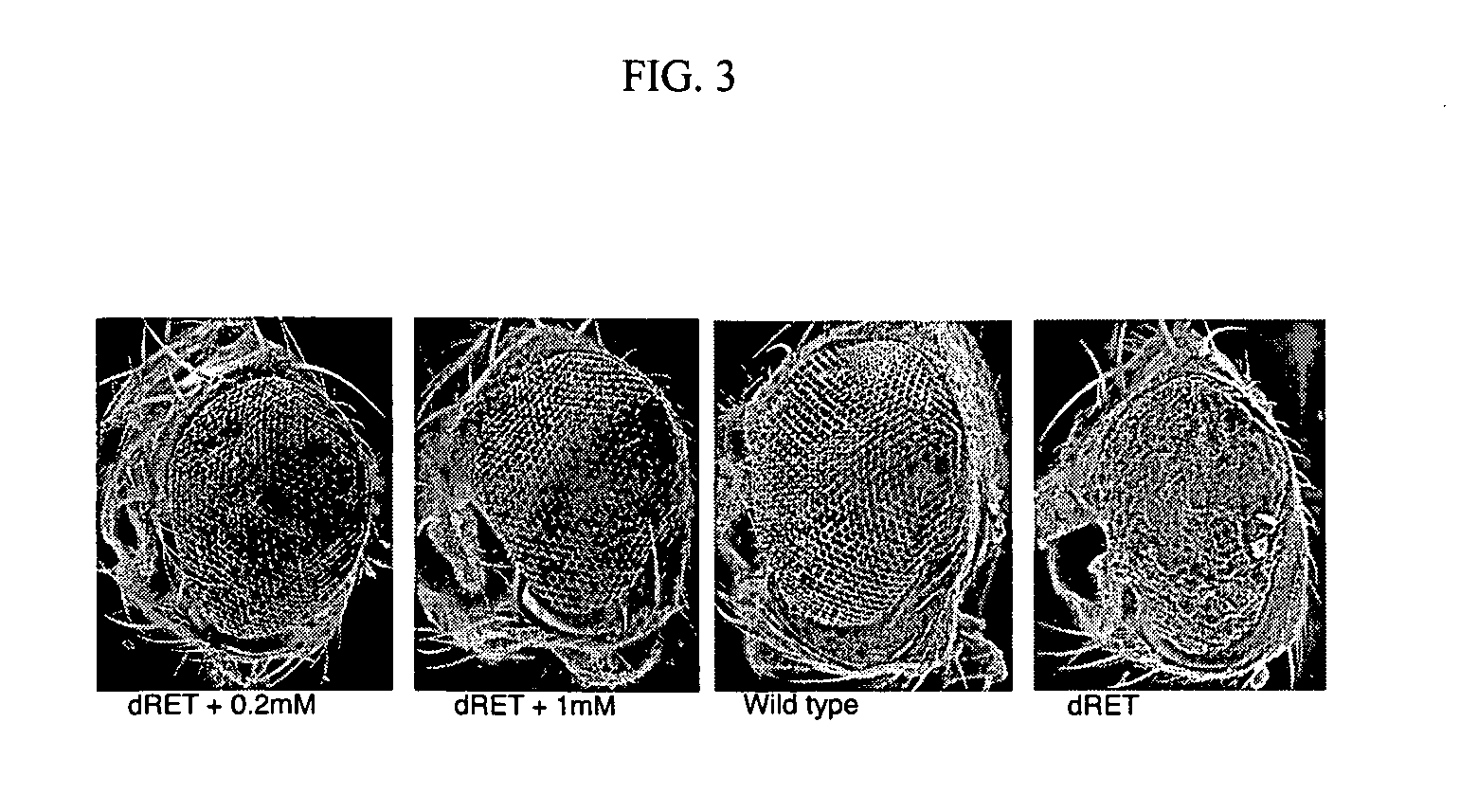High throughput cancer pharmaceutical screening using drosophila
a high-throughput, cancer-specific technology, applied in the direction of biochemistry apparatus and processes, animal husbandry, etc., can solve the problems of difficulty in microinjection of compounds of interest into numerous drosophila, and inability to detect orally absorbable drugs, etc., to achieve easy to practice, high throughput screening, and convenient adaptation to automated high-throughput systems
- Summary
- Abstract
- Description
- Claims
- Application Information
AI Technical Summary
Benefits of technology
Problems solved by technology
Method used
Image
Examples
example 1
dRet: Targeted Expression and Association with Cancer
[0070] To mimic the MEN2B mutation, a single methionine-to-threonine point mutation was engineered into a full-length dRet cDNA at codon 1007 (analogous to position 918 within human hRet subdomain VIII). To mimic the human MEN2A mutation, the cysteine at position 695 in dRet was altered to an arginine (C695R) that is in a position most analogous to hRet 634, one of the most commonly mutated sites in MEN2A patients. All mutated fragments were sequenced and returned to the original dRet clone to produce dRetMEN2A and dRetMEN2B. dRet, dRetMEN2A and dRetMEN2B were then fused 3′ to a GMR promoter construct that directs expression exclusively and at high levels in the eye (Moses and Rubin, 1991); stable transgenic lines were then created by standard protocol to yield GMR-dRet, GMR-dRetMEN2A, and GMR-dRetMEN2B.
[0071] Targeting MEN2A-analogous and MEN2B-analogous forms of dRet by standard methods for expression within the developing Dro...
example 2
Screening of ZD6474
[0073] A candidate therapeutic compound identified as ZD6474, obtained from AstraZeneca International, had previously been tested and found to reduce Ret activity in a tissue culture model (Carlomagno et al., 2002); this drug also shows some efficacy for VEGF-class receptors (Ciardiello et al., 2004; Ciardiello et al., 2003; Glade-Bender et al., 2003; Hennequin et al., 2002; Wedge et al., 2002). FIG. 3 illustrates in part the results of screening compound ZD6474 according to the screening methods of the present invention. Screening demonstrated the ability of ZD6474 to strongly inhibit the severity of the rough eye phenotype of both dRet and dRetMEN2B, indicating that the overgrowth and phenotypic defects were ameliorated. The panels in FIG. 3 demonstrate that the ZD6474 compound can rescue the dRetMEN2B phenotype in a concentration-dependent fashion. Overall, toxicity was observed at concentrations at and above 2.5 mM, and at least partial rescue was observed wi...
example 3
Drosophila Ortholog of C-Terminal Src Kinase (Csk) Regulates Cell Growth and Proliferation Through Inhibition of the Src, JNK, and STAT Pathway
[0075] The Src family cytoplasmic tyrosine kinases play important roles in a wide variety of cellular processes including proliferation and differentiation. Their major regulation is by C-terminal Src kinase (Csk), which encodes a negative regulator of Src tyrosine kinase signaling. The Drosophila ortholog of Csk, dCsk, functions as a tumor suppressor: dCsk mutants demonstrated increased body size and over-proliferation of adult tissues. Src family kinases regulate multiple cellular processes including proliferation and oncogenesis. Csk encodes a critical negative regulator of Src family kinases. We demonstrate that the Drosophila Csk ortholog, dCsk, functions as a tumor suppressor: dCsk mutants display organ overgrowth and excess cellular proliferation. Results of genetic analysis revealed that the dCsk phenotype depends primarily on activa...
PUM
| Property | Measurement | Unit |
|---|---|---|
| Permeability | aaaaa | aaaaa |
| Toxicity | aaaaa | aaaaa |
Abstract
Description
Claims
Application Information
 Login to View More
Login to View More - R&D
- Intellectual Property
- Life Sciences
- Materials
- Tech Scout
- Unparalleled Data Quality
- Higher Quality Content
- 60% Fewer Hallucinations
Browse by: Latest US Patents, China's latest patents, Technical Efficacy Thesaurus, Application Domain, Technology Topic, Popular Technical Reports.
© 2025 PatSnap. All rights reserved.Legal|Privacy policy|Modern Slavery Act Transparency Statement|Sitemap|About US| Contact US: help@patsnap.com



